
The Central Troy Historic District is an irregularly shaped, 96-acre (39 ha) area of downtown Troy, New York, United States. It has been described as "one of the most perfectly preserved 19th-century downtowns in the [country]" with nearly 700 properties in a variety of architectural styles from the early 19th to mid-20th centuries. These include most of Russell Sage College, one of two privately owned urban parks in New York, and two National Historic Landmarks. Visitors ranging from the Duke de la Rochefoucauld to Philip Johnson have praised aspects of it. Martin Scorsese used parts of downtown Troy as a stand-in for 19th-century Manhattan in The Age of Innocence.

The Downtown Albany Historic District is a 19-block, 66.6-acre (27.0 ha) area of Albany, New York, United States, centered on the junction of State and North and South Pearl streets. It is the oldest settled area of the city, originally planned and settled in the 17th century, and the nucleus of its later development and expansion. In 1980 it was designated a historic district by the city and then listed on the National Register of Historic Places.

There are 75 properties listed on the National Register of Historic Places in Albany, New York, United States. Six are additionally designated as National Historic Landmarks (NHLs), the most of any city in the state after New York City. Another 14 are historic districts, for which 20 of the listings are also contributing properties. Two properties, both buildings, that had been listed in the past but have since been demolished have been delisted; one building that is also no longer extant remains listed.

Park Square Historic District is a historic district located at Franklinville in Cattaraugus County, New York. The district encompasses the historic core of the village of Franklinville and include the landscaped village green, brickpaved streets, and the commercial or civic buildings fronting on the square or located immediately adjacent to it. Significant buildings range in date from 1828 to 1924 and reflect a variety of 19th-century and early 20th-century architectural styles including Queen Anne, Italianate, and Classical Revival styles. The village square was established in 1876. The district contains 21 contributing buildings and 2 contributing structures.
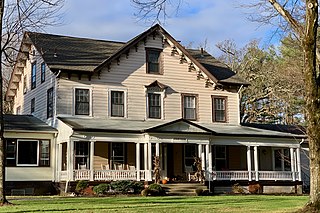
Schooley's Mountain Historic District is a historic district along Schooley's Mountain, Pleasant Grove, and Flocktown Roads, and Heath Lane in the Schooley's Mountain section of Washington Township, Morris County, New Jersey. It was added to the National Register of Historic Places on June 14, 1991 for its significance in architecture, entertainment/recreation, and health/medicine. The district includes 71 contributing buildings, such as the Oak Cottage, site of schoolhouse No. 5, Schooley's Mountain Store, the William W. Marsh House, Christadelphian Bible Camp, the former Heath House Hotel, former Forest Grove Hydropathic Institute, Mine Hill Farm, the Marsh Mine and several private residences and commercial buildings.

The American Security and Trust Company Building is a Neoclassical bank office in Washington, D.C., designed by the architectural firm of York and Sawyer. It was listed on the National Register of Historic Places in 1973.

Hudson Falls Historic District is a national historic district located at Hudson Falls in Washington County, New York. It includes 148 contributing buildings, one contributing site, and two contributing objects. It encompasses the historic center of the village including residential, commercial, civic, and ecclesiastical buildings, centered on the village park. The buildings were built between 1812 and 1935, the majority between 1875 and 1900, and reflect a variety of 19th and early-20th-century architectural styles. Located within the district is the former Washington County Courthouse (1873) and the separately listed US Post Office-Hudson Falls. One of the oldest structures is a law office building constructed about 1810 and located at 177 Main Street. It is notable as having been the office for Henry C. Martindale (1780-1860) and his clerk, New York Governor Silas Wright (1795-1847).

The Downtown Gloversville Historic District is a national historic district located in Gloversville, Fulton County, New York. It is roughly bounded by Spring, Prospect, West and East Fulton, North and South Main, and Elm Streets.

Bemis Eye Sanitarium Complex is a historic sanatorium complex located at Glens Falls, Warren County, New York. The complex was built between about 1893 and 1902 and consists of eight contributing structures. The architect was Ephraim Potter. There are five boarding houses built for the sanitarium, as well as two previously existing residences and a carriage house that were converted for sanitarium use in the 1890s.
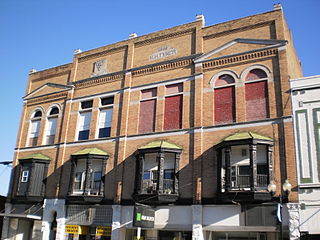
The Hartford City Courthouse Square Historic District is located in Hartford City, Indiana. Hartford City has a population of about 7,000 and is the county seat of Blackford County and the site of the county courthouse. The National Park Service of the United States Department of the Interior added the Hartford City Courthouse Square Historic District to the National Register of Historic Places on June 21, 2006 — meaning the buildings and objects that contribute to the continuity of the district are worthy of preservation because of their historical and architectural significance. The District has over 60 resources, including over 40 contributing buildings, over 10 non-contributing buildings, 1 contributing object, 8 non-contributing objects, and two other buildings that are listed separately in the National Register.

The Monroe County Courthouse in Albia, Iowa, United States, was built in 1903. It was listed on the National Register of Historic Places in 1981 as a part of the County Courthouses in Iowa Thematic Resource. In 1985 it was listed as a contributing property in the Albia Square and Central Commercial Historic District. The courthouse is the third building the county has used for court functions and county administration.
The New Cordell Courthouse Square Historic District is a district comprising the historic commercial center of New Cordell, Washita County, Oklahoma. The district grew around the Washita County Courthouse site, which was planned in 1897 when the townsite was laid out. The commercial buildings surrounding the courthouse were mainly built from 1900 to 1925; some newer buildings, including several on First Street, are also part of the district. 80 buildings are included in the district, of which 52 are considered contributing buildings to the district's historic character. The district was added to the National Register of Historic Places on January 7, 1999.

Watkins Glen Commercial Historic District is a national historic district located at Watkins Glen in Schuyler County, New York. It encompasses 33 contributing buildings in the central business district of Watkins Glen. It developed between about 1844 and 1939 and includes notable examples of Greek Revival, Italianate, Classical Revival, Colonial Revival, Second Empire and Romanesque Revival style architecture. Notable buildings include the Watkins Glen Municipal Building (1939), Watkins Glen Fire Station (1935), Watkins State Bank (1911), Hotel Kendall (1891), Haring Building (1844), former Watkins Post Office (1905), Freer Opera House, and the Durand Block (1897).
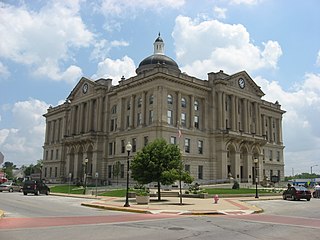
Huntington Courthouse Square Historic District is a national historic district located at Huntington, Huntington County, Indiana. The district includes 102 contributing buildings and 3 contributing structures in the central business district of Huntington. It developed between about 1845 and 1942 and includes notable examples of Italianate, Queen Anne style architecture in the United States, Romanesque Revival, Neoclassical, and Commercial style architecture. Located in the district are the separately listed Moore/Carlew Building and Hotel LaFontaine. Other notable buildings include the Hotel Huntington (1848), Opera House (1881), Lewis Block, Huntington County Courthouse (1904), old Post Office (1916), Citizens' State Bank, City Hall / Fire Station (1904), Huntington Light and Fuel Building, Our Sunday Visitor building (1926), YMCA (1929), and Huntington Theater.

Winterset Courthouse Square Commercial Historic District is a nationally recognized historic district located in Winterset, Iowa, United States. It was listed on the National Register of Historic Places in 2015. At the time of its nomination the district consisted of 82 resources, including 74 contributing buildings, seven noncontributing buildings, and one noncontributing object. The historic district covers most of the city's central business district in the original town plat. Most of the buildings are two-story, brick, commercial buildings. The commercial Italianate style is dominant, with Queen Anne, Romanesque Revival, and Neoclassical styles included. The Madison County Courthouse (1878) is a Renaissance Revival structure designed by Alfred H. Piquenard. Most of the buildings are brick construction, but four were constructed using locally quarried limestone. The stone buildings include the courthouse, the White, Munger and Company Store (1861), and the Sprague, Brown, and Knowlton Store (1866), all of which are individually listed on the National Register.

The New Center Commercial Historic District is a commercial historic district located on Woodward Avenue between Baltimore Street and Grand Boulevard in Detroit, Michigan. It was listed on the National Register of Historic Places in 2016.

The Ellsworth–Jones Building is a historic building located in Iowa Falls, Iowa, United States. Eugene S. Ellsworth was a land broker, town developer, and philanthropist. This building was the headquarters of his firm Ellsworth and Jones, who sold land throughout Iowa and other states in the Midwest. While Iowa Falls was their headquarters, they also had offices in Chicago, Boston, and Crookston, Minnesota. The three-story, brick Neoclassical building was completed in 1902. It features Ionic and Doric columns, egg-and-dart motif on the lower level columns, round arches, acanthus leaf keystones, foliated decorative elements, a dentils on the cornice.

The Washington Avenue Commercial Historic District is a nationally recognized historic district located in Iowa Falls, Iowa, United States. It was listed on the National Register of Historic Places in 2012. At the time of its nomination the district consisted of 59 resources, including 42 contributing buildings and 15 non-contributing buildings. The district takes in most of the city's central business district. The buildings here were generally used for retail and office purposes. An opera house and theater are also located here. Around the edges of the district are buildings that housed automobile dealerships. The buildings generally range from one to two stories, but a couple structures are three stories in height. Built between the 1857 and 1960, the buildings are composed of masonry construction. The commercial Italianate and Classical Revival styles are dominant.
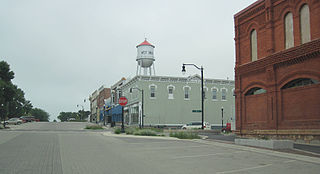
The West Union Commercial Historic District is a nationally recognized historic district located in West Union, Iowa, United States. It was listed on the National Register of Historic Places in 2015. At the time of its nomination the district consisted of 56 resources, including 38 contributing buildings, one contributing structure, and 17 noncontributing buildings. West Union was platted in 1850 and retail businesses began the same year around the public square. The square also served as the center for county government and as a place for many of the community's social activities. The wide streets and sidewalks in the central business district also facilitated the city's commercial and social life. The buildings in the district have housed various commercial businesses, government operations, and churches. The residential buildings are mostly associated with the churches. Most of the buildings are one and two-stories in height, although a couple are three-stories, and built of brick. Most of them are in the revival styles built in the Victorian era, including Italianate, Queen Anne, Neoclassical, and Colonial Revival. There are also buildings designed in the Commercial style. Several buildings were designed by architects, but for the most part the designers are unknown. The city's water tower is the contributing structure. The First Baptist Church (1867), Hobson Block (1885), Maple View Sanitarium (1903), and the Fayette County Courthouse (1923) are all individually listed on the National Register of Historic Places.
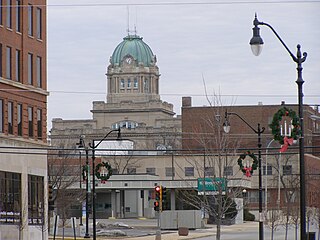
The Kankakee Downtown Historic District is a national historic district in downtown Kankakee, Illinois. The district includes 73 buildings which form the commercial and governmental center of the city, most of which are grouped along Court Street and Schuyler Avenue. While development in the district began in the 1850s, the oldest surviving building in the district is from 1864; the newest contributing buildings are from the mid-twentieth century. Kankakee's Courthouse Square and the 1908 Kankakee County Courthouse are part of the district; other government buildings in the district include Kankakee's post office, police and fire station, and armory. Most of the district's other buildings are one- to three-story brick or stone commercial buildings. Many popular architectural styles of the nineteenth and twentieth centuries are represented in the district; the Italianate, Neoclassical, and Art Deco styles are among the most common.























